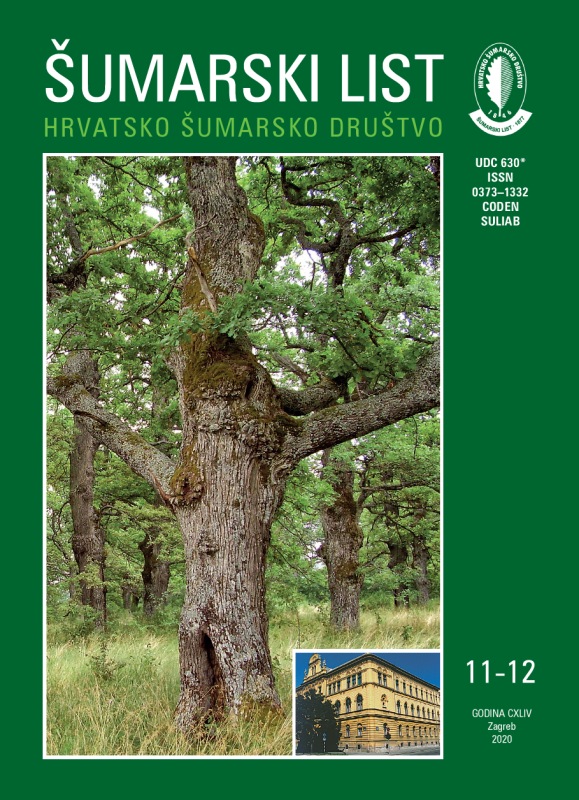
broj: 11-12/2020
pdf (5,77 MB) |
|
||||||||||||||
| RIJEČ UREDNIŠTVA | ||
| Uredništvo | ||
| The construction of the Danube – Sava canal and the EU Green transition pdf HR EN | 537 | |
| IZVORNI ZNANSTVENI ČLANCI | ||
| Igor Poljak, Joso Vukelić, Antonio Vidaković, Marijan Vuković, Marilena Idžojtić | UDK 630* 164 +165 (001) https://doi.org/10.31298/sl.144.11-12.1 | |
| Variability of the populations of scots pine (Pinus sylvestris L.) in the northwestern part of Mala Kapela according to the morphological characteristics of the needles and cones pdf HR EN | 539 | |
| Mario Slatki, Jelena Kralj | UDK 630* 148.2 + 653 (001) https://doi.org/10.31298/sl.144.11-12.2 | |
| Habitat selection of secondary hole-nesting birds in riverine forests along Drava river in Croatia pdf HR EN | 551 | |
| Murat Kose, Caglar Ugurlu, Omer Oncul, Fatih Demirci, Ilker Angin | UDK 630* 164 (001) https://doi.org/10.31298/sl.144.11-12.3 | |
| The use of sewage sludge and diatomite as growing medium in scots pine (Pinus sylvestris L.) seedling production and evaluation of its land performance pdf HR EN | 559 | |
| Amina Mašić | UDK 630* 969 (001) https://doi.org/10.31298/sl.144.11-12.4 | |
| Women in forestry in Bosnia and Herzegovina pdf HR EN | 565 | |
| A. Pilipović, M. Drekić, S. Stojnić, N. Nikolić, B. Trudić, M. Milović, L. Poljaković-Pajnik, M. Borišev, S. Orlović | UDK 630* 161 (001) https://doi.org/10.31298/sl.144.11-12.5 | |
| Physiological responses of two pedunculate oak (Quercus robur L.) families to combined stress conditions – drought and herbivore attack pdf HR EN | 573 | |
| Vladan Popović, Aleksandar Lučić, Ivona Kerkez Janković, Ljubinko Rakonjac, Saša Bogdan | UDK 630* 164 + 232.3 (001) https://doi.org/10.31298/sl.144.11-12.6 | |
| Variations in fruit traits of wild cherry (Prunus aviumL.) provenances in Serbia pdf HR EN | 585 | |
| PREGLEDNI ČLANCI | ||
| Damir Drvodelić, Milan Oršanić, Mirjana Grahovac-Tremski | UDK 630* 232.3 https://doi.org/10.31298/sl.144.11-12.7 | |
| Nursery production of forest fruit trees in nurseries of Croatian forests d.o.o. pdf HR EN | 597 | |
| Summary The article defines the term forest fruit trees or forest fruits that have been present in Croatian forestry for years and compares the term with other terms that are not synonymous and refer to forest trees, shrubs and ground growth of edible and medicinal fruits, wild fruits and domesticated fruits. Typical species representatives are listed for each term. The production by types of trees in the nurseries of Hrvatske šume d.o.o. is shown. in 2019/2020 years according to Forest Administration (FD), organizational units and nurseries. Regarding the production of forest fruit trees, edible and medicinal fruit trees, wild fruits and domesticated fruits, it is present in only three nurseries of Hrvatske šume d.o.o. (Zelendvor, Oštarije and Lukavec). In these three nurseries, a total of only four species from the above four categories are produced (2019/2020): service tree, wild cherry, sweet chestnut and black walnut. All four species are produced in the Zelendvor nursery, while in the Oštarije nursery, wild cherry seedlings are also produced, and in the Lukavec nursery only wild cherry seedlings are produced. The production and delivery of planting material of these species from the nursery of Hrvatske šume d.o.o. is shown. for the period 2012 to 2017. In stock or in production, in all nurseries of Hrvatske šume d.o.o. for the period from 2012 to 2018, there were mostly black walnut seedlings in the amount of 183,670 pieces, followed by seedlings of wild cherry with 132,069 pieces, sweet chestnut with 53,010 pieces and wild pear with 4,882 pieces. The most delivered seedlings, according to production, were black walnuts in the amount of 191,435 pieces, followed by wild cherry seedlings with 71,954 pieces, sweet chestnuts with 28,515 pieces and wild pears with 2,860 pieces. In the observed research period (2012-2018) in all nurseries of Hrvatske šume d.o.o. only 4 species from the above categories were produced with a total stock or production of 373,631 pieces of forest seedlings and a delivery of 294,764 pieces. In total, for all four species, it can be seen that 78,867 pieces of seedlings were grown more than delivered. Due to the possibility of organic farming, good adaptability of species to global climate change, providing incentives and not too demanding care, in the near future there will be increasing emphasis on species breeding to obtain secondary or non-timber forest products in plantations. Due to changing climatic conditions and the synergy of a number of unfavorable biotic and abiotic factors, many indigenous species are endangered today and are gradually or abruptly drying up and decaying. Some species of forest fruit trees, forest trees, shrubs and ground growth of edible and medicinal fruits, wild fruits and domesticated fruits will benefit from climate change, which will lead to the expansion of their natural range with increasing potential areas suitable for artificial cultivation. Key words: nursery production; black walnut; wild cherry; wild pear; service tree | ||


